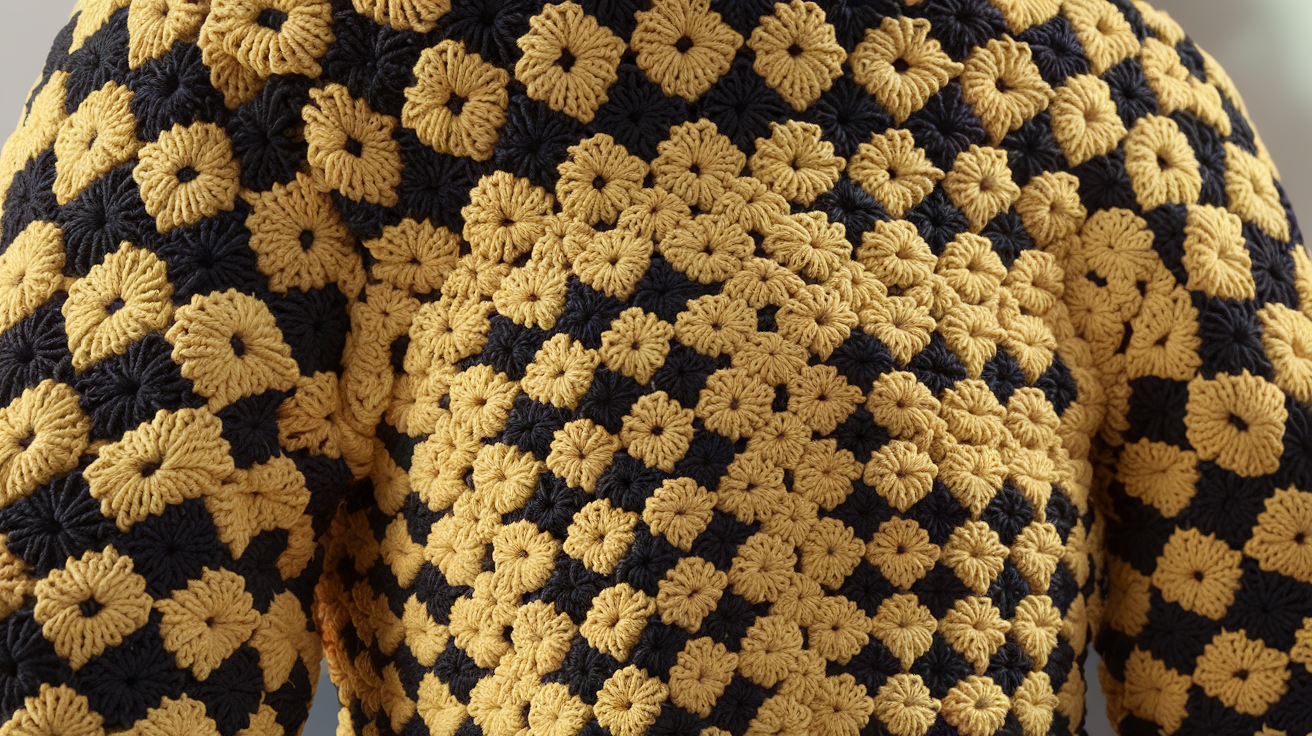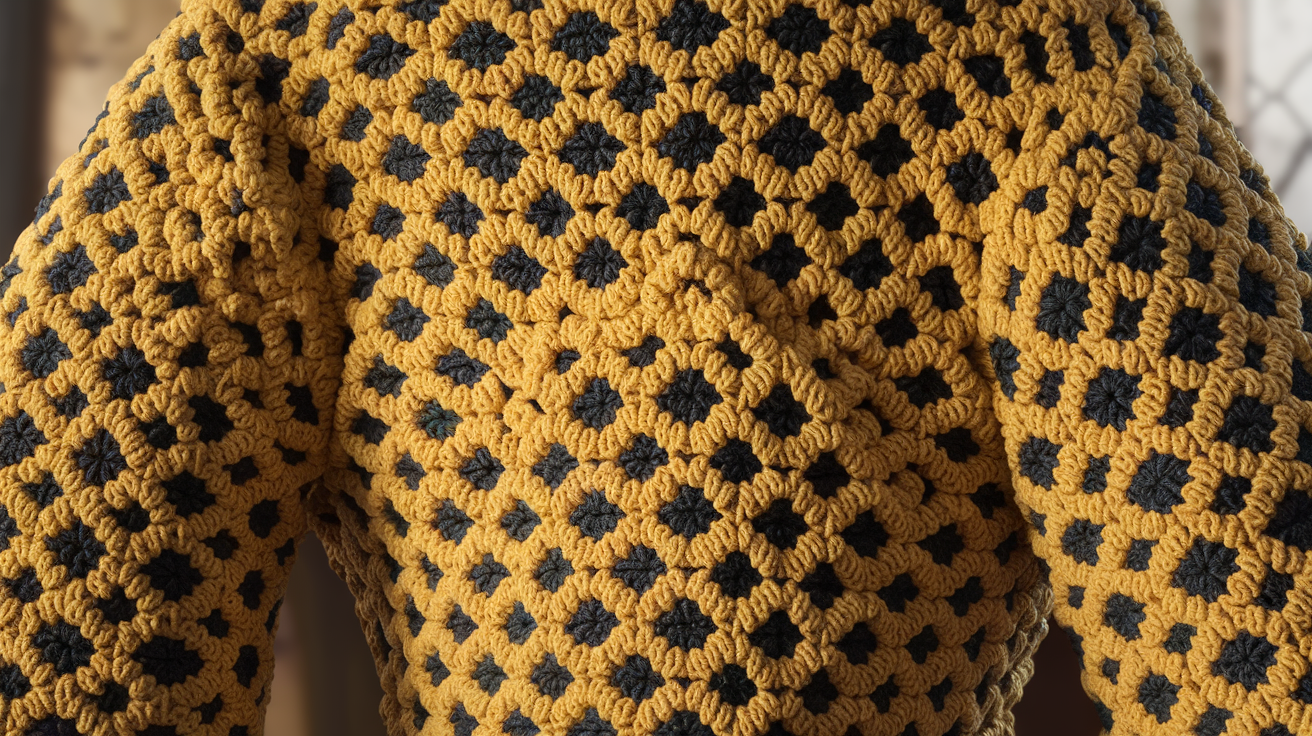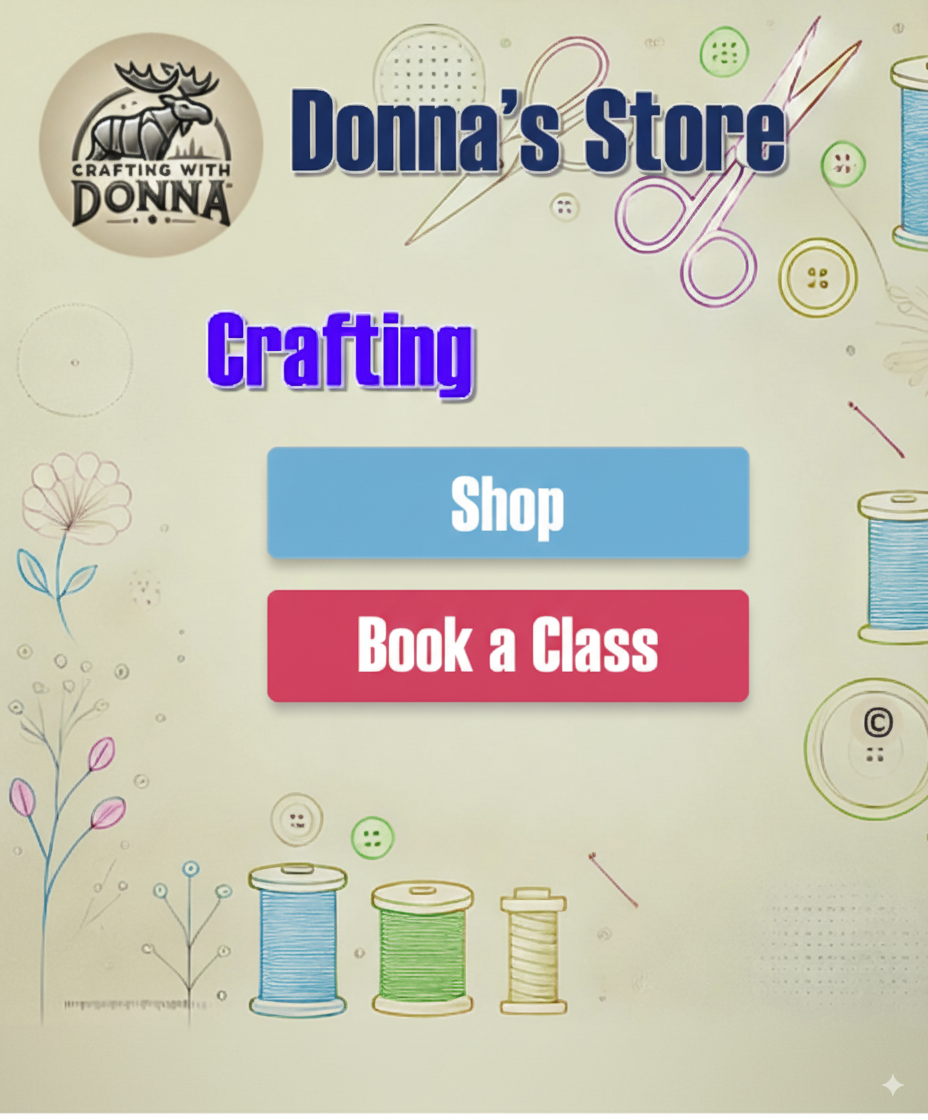How To Crochet A Honeycomb Cardigan With Granny Squares

Crochet techniques, specifically the charming bobble stitch, create the delightful honeycomb texture defining this cardigan’s appeal. These bobble granny squares offer a cozy depth and a touch of vintage style, making it a standout piece.
Fluffy yarn crochet is paramount for achieving that sought-after warmth and luxurious feel throughout the garment.
Carefully measuring each bobble square allows for a perfect custom fit, particularly for the fashionable cropped silhouette and the voluminous balloon sleeve crochet design.
The clever granny square assembly, using methods like the single crochet join or the continuous join, transforms individual squares into a cohesive piece of wearable art with clean, professional seams. This unique bobble stitch cardigan design and its intricate construction result in a trendy, handmade sweater that will undoubtedly become a cherished item within your fiber arts collection.
Your next step involves Choosing Your Fluffy Yarn.
Choosing Your Fluffy Yarn
Yarn selection is the foundation for crafting a luxuriously soft granny square cardigan, so prioritize fibers that promise plushness. Consider options like brushed acrylic yarn for easy care, luxurious merino wool yarn for exceptional softness, or even novelty yarns such as chenille and faux fur for unique texture and abundant warmth.
For the honeycomb cardigan crochet, using bulky yarn or a substantial worsted weight yarn will create a thicker, wonderfully cozy fabric that truly accentuates the bobble detail.
A yarn with a solid ply, ideally between 2 and 4 plies, will provide a better drape, essential for creating elegant balloon sleeves and ensuring the garment’s durability.
Crochet craft experts often suggest fluffy or brushed yarn finishes to enhance the distinctive honeycomb effect; it’s best to avoid slick, tightly spun strands if a cozier outcome is desired. When it comes to handmade sweater care, differentiating between fiber types is key—machine wash acrylics, but always lay wool or delicate blends flat to dry to maintain their softness and longevity, ensuring your DIY fashion piece lasts for years.
Fiber Types and Weights
Soft yarn is essential for a cloud-like feel; exploring options such as acrylic yarn, alpaca yarn, or mohair yarn can provide the plushness you desire for a truly cozy experience.
Worsted weight yarn and DK weight yarn are excellent choices, offering a good balance between warmth and stitch definition for this project. Merino wool yarn and wool blend yarn also lend themselves beautifully to this cardigan’s design, providing natural warmth and a soft hand.
For an extra touch of luxury and texture, consider alpaca yarn or mohair yarn, which can significantly enhance the fluffy aesthetic.
Ply and Drape
Yarn crafting involves understanding how yarn ply influences the final fabric – a solid ply, typically from 2 to 4 strands twisted together, offers improved drape and greater durability than single-ply yarns.
Gauge swatch creation helps confirm your yarn’s behavior, ensuring the intended drape for the balloon sleeve crochet and overall fit.
Crochet instructions often emphasize using yarns with good elasticity to prevent stretching out of shape, especially in a garment like this.
Enhancing Fluffiness
Textured crochet is amplified by choosing fluffy fibers; look for yarns specifically labeled as brushed, boucle, or novelty to boost the honeycomb effect. Bobble stitch cardigan projects benefit greatly from yarns that can hold shape while still providing a soft, inviting texture.
Crochet tips suggest experimenting with different yarn textures to see how they interact with the bobble stitch, ensuring a visually appealing and tactilely pleasing outcome for your crochet project.
Care and Longevity
Garment making necessitates proper care to maintain the beauty of your creation; acrylic yarn is generally machine washable and dryable on low heat. Natural fibers like merino wool yarn or alpaca yarn typically require hand washing in cool water and laying flat to dry to prevent shrinking or felting.
Finishing techniques, including proper blocking, can help set your stitches and ensure the cardigan retains its shape and softness over time, making it a true piece of wearable art.

Mastering the Bobble Granny Square
Bobble stitch placement unlocks the bold, textural style that defines a honeycomb cardigan. Granny square cardigan makers achieve greater dimension by mapping bobbles at the center or corners of each square; this highlights the honeycomb effect and increases visual impact.
Yarn crafting offers many alternative bobble stitch methods, like the puff and popcorn stitches, adding unique texture—offering variety for creative crocheters pursuing eye-catching results.
Yarn selection matters greatly; worsted weight yarn ensures crisp, raised bobble detail, while fluffy yarn crochet with bulky weights achieves plush, cloud-like pops.
To maintain professional, even bobble size throughout your crochet project, count each yarn over and keep tension consistent across all stitches. Crafting uniform bobbles results in a cohesive, polished square ready for a stylish, modern crochet garment, ideal for DIY fashion or a handmade sweater creation.
Strategic Bobble Placement
Bobble detail placement significantly contributes to the visual appeal of your work.
Crochet techniques for bobble placement involve strategically positioning them to create patterns, adding depth. For instance, placing bobbles on the interior of a square can create a subtle texture, while concentrating them along the edges or at corners can provide a more pronounced decorative effect, enhancing the overall design of a stylish sweater or a cozy cardigan.
This careful consideration of where each bobble stitch appears truly elevates the finished piece, making it a true wearable art.
Varied Bobble Textures
Stitch variations extend beyond the basic bobble, offering diverse textures for your projects.
Exploring alternative bobble stitch techniques, such as the puff stitch or popcorn stitch, adds a different dimension of fluffiness and definition to your crochet craft.
These methods can yield slightly different visual and tactile results, allowing for greater creative expression in your garment making. Selecting the right yarn selection is also key; softer, fluffier fibers like mohair yarn or wool blend yarn can enhance the plushness of these stitches, creating a wonderfully cozy and luxurious feel for any project.
Optimizing Bobble Definition
Yarn selection plays a key role in achieving optimal bobble definition.
For a crisp, defined bobble, consider using yarns like worsted weight yarn or DK weight yarn. These weights provide enough structure for stitches to pop without becoming lost.
Conversely, fluffy yarn crochet using bulky yarn or novelty yarn can create softer, more diffused bobbles that contribute to a wonderfully plush and inviting texture, perfect for a cozy cardigan.
Whichever path you choose, pay close attention to your stitch count and tension for the best results.
Consistent Bobble Sizing
Crochet tips for consistent bobble size are paramount for a polished appearance.
To achieve uniform bobbles across your granny square method, strive for consistent tension in every stitch. Counting your yarn overs for each bobble, particularly when using different stitches or yarn types, helps maintain regularity.
Practicing with a gauge swatch beforehand, using your chosen yarn and hook, will also ensure all your bobble patterns are the same size, making your joining squares process smoother.
Granny Square Assembly Guide
Granny square assembly is the strategic process that transforms individual bobble granny squares into a refined cropped cardigan pattern. Joining squares with invisible seam techniques like slip stitch, whip stitch, or a continuous join gives your textured crochet garment a flawless finish.
Yarn weight choices should remain consistent with your original squares, as using the same worsted or bulky yarn maintains the correct gauge for seamless assembly and prevents distortion.
When planning layout, organize your squares according to sleeve construction and cropped silhouette for accurate sizing and aesthetically pleasing sleeve and body proportions.
Reinforce joins at high-stress points—such as underarms and shoulder seams—using extra stitches or a finer yarn to boost structural integrity, ensuring your handmade sweater stands up to everyday wear in cozy fashion crochet style.
Seamless Joining Methods
Joining squares with invisible seam techniques ensures your finished crochet project looks professional. Methods such as the slip stitch, whip stitch, or a continuous join create clean, nearly invisible seams, allowing the textures of your bobble detail to stand out.
These techniques are essential for sophisticated garment making, contributing to a polished look for any handmade sweater or cozy cardigan. Practicing these methods on smaller swatches of your chosen yarn, whether it’s merino wool yarn or acrylic yarn, will build confidence for joining the entire piece.
Strategic Square Layout
Granny square assembly requires careful planning of your square layout for optimal garment shaping.
Organizing your crocheted squares according to your desired cropped silhouette and sleeve construction is key.
For example, when creating balloon sleeve crochet, you will need to arrange more squares to achieve the desired width for the sleeves compared to standard sleeves.
Considering the overall stitch count and how squares will fit together prevents distortion and ensures a flattering fit for your stylish sweater, offering a beautiful blend of retro fashion and modern crochet.
Reinforcing Key Joining Points
For enhanced structural integrity in your crochet project, reinforcing key joining points is advisable. This involves adding extra stitches or using a slightly finer yarn at areas experiencing more stress, such as shoulder seams or underarm areas.
Proper reinforcement ensures your handmade sweater, whether a beginner crochet item or an advanced crochet piece, maintains its shape and durability over time. This attention to detail elevates your craft inspiration and results in a garment that’s both beautiful and resilient, making it a perfect gift idea crochet.
| Yarn Weight Recommendation | Bobble Definition | Texture Result |
|---|---|---|
| Worsted Weight Yarn | Crisp, Raised Bobble Detail | Defined, Structured |
| Bulky Weight Yarn | Plush, Cloud-like Pops | Soft, Inviting |
| DK Weight Yarn | Clear, Defined Bobble | Neat, Polished |
| Novelty Yarn | Softer, More Diffused Bobbles | Unique, Plush |
Crocheting Balloon Sleeves
Transforming a simple sleeve into a balloon sleeve crochet masterpiece begins with mastering stitch shaping and mindful assembly. Increasing your stitch count at the upper and midsections creates signature fullness, while strategic decreases at the cuff retain the classic puffy silhouette associated with textured crochet cardigans.
When planning sleeve construction, precise joining of bobble granny squares is essential for a seamless transition to the main body, mirroring the granny square assembly of a honeycomb cardigan.
For successful yarn management around the sleeve’s circumference, use stitch markers and manage yarn tails for a tidy, professional finish—especially helpful on larger DIY fashion projects using fluffy yarn crochet techniques.
Select soft yarn for ultimate comfort and visual appeal, a key step in creating your garment.
Crochet sample bobble granny squares, then measure them to determine how many are needed for your desired size and shape, a process essential for garment making. Join squares for front, back, and sleeves using slip stitch, whip stitch, or continuous join techniques, a fundamental assembly technique.
Assemble squares to shape the cropped silhouette and balloon sleeves; sleeve sizing depends on square number and arrangement within your crochet project. Add ribbing, cuffs, and finishing details to polish the cardigan, enhancing its wearable art appeal.
Use suitable blocking to smooth seams and enhance the garment’s drape, ensuring a well-fitted, stylish sweater for your yarn crafting collection.
Crocheting Techniques for Cardigans
Creating a granny square cardigan that balances coziness and structure hinges on smart construction choices and stitch adaptations.
Cardigan construction methods vary significantly, with bottom-up approaches (often used in honeycomb cardigans) involving the stepwise joining of squares for the body and sleeves, while top-down builds start from the neckline for faster assembly.
Adapting stitches like the bobble stitch cardigan or using tighter crochet techniques on button bands adds both texture and stability to the garment, improving its overall durability. The choice of stitches and yarn—from plush fluffy fibers to dense joins—directly influences the cardigan’s drape and comfort.
For finishing touches, crocheting ribbed or slip stitch button bands and neckline edges ensures polished, handmade sweater appeal in any stylish or vintage crochet cardigan project, reflecting beautiful fiber arts.
Cardigan Construction Approaches
Cardigan construction methods offer distinct pathways to building your handmade sweater. The bottom-up approach, often seen in granny square cardigan designs, involves assembling and joining individual squares or sections sequentially to form the body and sleeves.
Conversely, top-down builds commence at the neckline, gradually expanding the garment to create the body and sleeves, a method that can sometimes facilitate quicker assembly and easier sleeve integration for beginner crochet enthusiasts.
Understanding these different crochet instructions is key to selecting a method that suits your project and skill level.
Adapting Stitches for Structure
You can adapt common crochet stitches for a more structured cardigan fabric, significantly impacting the finished garment’s feel and appearance.
Tighter stitches or specific stitch variations used on edges like button bands or necklines provide neatness and prevent stretching, contributing to the overall polish of a crochet craft project. Using stitches such as single crochet or slip stitch for edging can create a firm border, contrasting nicely with the looser stitches used for the main body, enhancing the textured crochet elements.
Employing a denser fabric also means your cozy cardigan will hold its shape better over time against frequent wear.
Linking Stitches to Comfort and Drape
The selection of stitches and yarn type directly influences a cardigan’s comfort and drape. For instance, using bulky yarn or incorporating stitches that create loft, like the bobble stitch, results in a warmer, more substantial garment that provides excellent coziness.
Softer yarns such as merino wool yarn or alpaca yarn contribute to a plush feel, enhancing the comfort factor of your DIY clothing.
Conversely, yarns with less elasticity or stitches that create a dense fabric can lead to a more structured drape.
The ultimate balance depends on your desired tactile experience and the overall aesthetic of your fashion crochet design.
Finishing Touches: Button Bands and Necklines
Polishing your cardigan involves meticulous attention to finishing techniques, particularly around button bands and neckline edges, ensuring a professional look for your crafty projects. Crocheting a defined edge, such as a ribbed band using front and back post stitches or a clean slip stitch border, adds structure and prevents fraying.
For button bands, ensuring consistent tension is key to a neat appearance, and the placement of buttonholes will depend on your chosen button size and the overall garment’s fit. Adding a well-worked neckline, whether it’s a simple crochet edge or a more intricate pattern, completes the aesthetic of your stylish sweater, making it a desirable gift idea crochet.
- Mastering stitch shaping and mindful assembly, including increasing stitch count in upper and midsections and strategic decreases at the cuff, is crucial for creating balloon sleeves with their signature fullness and classic puffy silhouette.
- Precise joining of bobble granny squares is essential for a seamless transition to the main body of a cardigan, mirroring the assembly of other granny square designs.
- Selecting soft yarn, crocheting sample squares to determine quantity, and using appropriate joining techniques like slip stitch or whip stitch are fundamental steps in garment making for projects like balloon sleeve cardigans.
- Cardigan construction methods, whether bottom-up or top-down, along with adapting stitches for structure on edges and choosing yarns that influence comfort and drape, significantly impact the final appearance and wearability of a handmade sweater.
Textured Crochet for Comfort
Explore how different stitch combinations create tactile interest beyond basic patterns. Connecting stitch texture to yarn choice emphasizes fibers that enhance coziness.
Discover practical advice on how to achieve a soft hand-feel in finished garments.
Suggest specific textured stitches that are conducive to relaxing wear.
Exploring Stitch Variations
Textured crochet techniques transform simple patterns into cozy, visually striking wearable art by using varied stitch combinations and thoughtfully selected yarn types. Bobble stitch and popcorn stitches create plush, raised surfaces that lend a honeycomb effect to cardigans, while techniques like front post double crochet and surface crochet add depth and tactile interest for a true bobble stitch cardigan.
Choosing fluffy yarn—such as acrylic blends, mohair yarn, or chenille—further enhances coziness and softness, making each granny square irresistibly touchable. For a soft hand-feel, pre-washing natural fibers, working with slightly larger hooks, and maintaining a relaxed gauge are essential tips for your next cozy cardigan.
Practical stitches for relaxing wear include the moss stitch, shell stitch, bean stitch, and Prairie stitch—each delivering gentle, soothing textures.
Enhancing Coziness with Yarn Selection
Selecting the perfect fluffy fibers significantly contributes to the overall comfort of a crocheted piece.
Consider the benefits of bulky yarn and soft yarn when aiming for a truly snug garment.
Many crocheters opt for luxurious options like merino wool yarn, alpaca yarn, or mohamair yarn for their exceptional warmth and natural softness. Similarly, blends like wool blend yarn can offer a wonderful balance of properties.
Alternatively, acrylic and novelty yarns provide accessible softness and unique textures, making DIY fashion projects enjoyable for all skill levels. When making your yarn selection, think about how different textures, such as those from a bobble pattern, will interact with the chosen fibers.
Achieving a Soft Hand-Feel
To achieve a desirable soft hand-feel in your finished garments, several practical approaches can be employed.
It is often beneficial to block crochet pieces before assembly, as this process smooths out stitches and evens out the fabric.
When selecting your yarn crafting materials, natural fibers like wool and alpaca often soften considerably after washing.
Using a slightly larger hook than recommended for a particular weight of yarn can also create a looser, softer fabric. Maintaining a consistent, relaxed tension throughout your crochet craft is equally important for a more pliable result.
This attention to detail in your crochet instructions ensures a more comfortable and luxurious final product.
Recommended Textured Stitches
Several stitch variations naturally lend themselves to creating relaxing and comfortable wear. The moss stitch, also known as the granite stitch, produces a dense yet flexible fabric that is wonderfully soft.
Similarly, the shell stitch provides a beautiful, scalloped texture that adds visual interest without stiffness.
The bean stitch creates a slightly raised, bumpy texture that is both cozy and unique.
For an even more pronounced tactile experience, consider stitches like the Puff stitch or the very popular bobble stitch, which add delightful dimensionality. These stitch variations are perfect for projects like a cozy cardigan or a stylish handmade sweater.
Cardigan Style and Fit
Relate fit considerations to the yarn’s drape and stitch definition.
Provide guidance on how to measure for a flattering cardigan fit. Explain how to adjust patterns for different body shapes and desired silhouettes.
Offer styling tips to maximize the aesthetic appeal of a crocheted cardigan.
Measuring for a Flattering Fit
Cardigan style and fit begin with understanding how yarn drape and stitch definition work together to shape the finished garment, especially when planning a cropped cardigan pattern or balloon sleeves.
Precise measurement is key; track bust circumference, shoulder width, sleeve sizing, and overall length before joining squares for your granny square cardigan. To ensure a flattering fit for your crochet project, it is essential to create a gauge swatch.
This allows you to check your tension and accurately calculate the number of stitches and rows needed. Adjusting the square quantities for a customized silhouette is simple; whether you desire a laid-back cropped silhouette or a fuller balloon sleeve crochet effect, thoughtful measurement is paramount.
Adjusting Patterns for Silhouettes
Tailoring your crochet pattern to achieve desired silhouettes involves strategic adjustments in square assembly and stitch count.
When aiming for a cropped cardigan pattern, you’ll want to carefully plan the number of squares needed for the back and front panels to achieve that shorter length.
For styles featuring balloon sleeve crochet, you will typically increase the number of squares used for the sleeve width to create that voluminous effect, then taper them towards the cuff using specific sleeve construction techniques.
The granny square assembly process allows for significant personalization; by altering the number of squares used in different sections, you can create unique shapes and fits that flatter your individual body type. This adaptability makes DIY clothing projects wonderfully unique.
Styling Your Crocheted Cardigan
Maximizing the aesthetic appeal of your finished handmade sweater involves thoughtful styling choices that complement its texture and shape.
For a modern vibe, layer your creation over high-waisted jeans or a sleek skirt. If you’ve incorporated a distinctive bobble detail, consider pairing your cardigan with minimalist accessories to let the craftsmanship shine as wearable art.
A cropped cardigan looks fantastic with high-waisted bottoms, creating a balanced and contemporary look.
Alternatively, if you’ve opted for statement sleeves, such as balloon sleeves, keep the rest of your outfit relatively simple to allow the sleeves to be the focal point.
Don’t forget the impact of color; a vibrant hue can make your stylish sweater a true statement piece.
Finishing Techniques and Details
Elevating your crochet project to a professional standard often comes down to the finishing techniques applied. After completing the main construction, focusing on elements like ribbing, cuffs, and neckline finishes can dramatically enhance both the
Textured Crochet
- Stitches like the bobble stitch and popcorn stitches create plush, raised surfaces that add tactile interest.
- Fibers such as acrylic blends, mohair yarn, and chenille are recommended for enhancing coziness and softness.
- Practical stitches for relaxing wear include the moss stitch, shell stitch, bean stitch, and Prairie stitch.
- Blocking crocheted pieces before assembly is a key technique for achieving a soft hand-feel.
Cozy Cardigan Crafting Tips
Bobble stitch cardigans, much like the acclaimed Honeycomb Cardigan, benefit immensely from thoughtful yarn selection and finishing details. Utilizing fluffy yarn crochet with a slight halo amplifies softness and warmth, adding a premium touch to your DIY fashion project.
A moderate stitch tension, as you’d maintain for a bobble pattern, ensures your bobble detail yields a cozy, inviting drape, reminiscent of luxurious handmade sweaters.
This approach elevates your crochet project into true wearable art, showcasing sophisticated stitch variations.
When assembling your granny square assembly for a textured crochet piece, meticulous square joining and secure weaving of all ends prevent snagging and maintain plush comfort, a key aspect of successful garment making.
For a truly professional finish, blocking crochet is essential: gently soak and pin your finished cardigan into shape, letting it air dry for enhanced softness and improved stitch definition, a vital step in finishing techniques for any crochet craft.
If your project involves prolonged crocheting sessions, adopt ergonomic crochet techniques—such as using cushioned hooks and taking regular stretch breaks—to reduce wrist strain, ensuring the yarn crafting process remains enjoyable from start to finish. This mindful approach to advanced crochet or even beginner crochet ensures pleasure throughout your crafty projects and is a significant part of successful crochet instructions.
Mastering the Honeycomb Cardigan Construction
The Honeycomb Cardigan, a delightful example of modern crochet with hints of vintage crochet flair, is expertly crafted using bobble granny squares and fluffy yarn for a uniquely cozy, textured finish.
The strategic assembly of these squares, a key granny square method, results in a trendy cropped silhouette and stylish balloon sleeve crochet, all achieved by careful planning, measurement, and precise joining techniques. This crochet tutorial offers insight into creating a fashionable garment.
Yarn Selection for Ultimate Coziness
Selecting soft, fluffy yarn is paramount for both comfort and visual appeal in your stylish sweater.
Popular choices include roving and luxury fluffy blends, ideal for warmth and texture, making your handmade sweater exceptionally inviting.
Experimenting with different soft yarn types, such as merino wool yarn, alpaca yarn, or mohair yarn, can further enhance the luxurious feel of your fiber arts creation.
Strategic Square Joining and Assembly
Crochet sample bobble granny squares and measure them meticulously to determine the required quantity for your desired size and shape, a fundamental aspect of gauge swatch precision.
Join squares for the front, back, and sleeves using methods like slip stitch, whip stitch, or continuous join techniques, ensuring a secure fabric. The assembly of squares shapes the cropped cardigan pattern and balloon sleeves; sleeve sizing depends heavily on the square number and arrangement, a key consideration during sleeve construction.
Essential Finishing Touches
Add ribbing, cuffs, and other finishing details to polish your cardigan, transforming it into a standout piece of DIY clothing.
This is where your creative crafting truly shines. Consider adding faux fur trims for an extra touch of luxury.
Use suitable blocking to smooth seams and enhance the garment’s drape, a crucial step for a professional outcome in any advanced crochet or even intermediate crochet project.
| Yarn Type Recommendation | Assembly Technique | Finishing Essential | Crochet Skill Level |
|---|---|---|---|
| Fluffy yarn crochet (e. g. , roving, merino, alpaca, mohair blends) | Meticulous square joining (slip stitch, whip stitch, continuous join) | Blocking for softness and stitch definition | Beginner to Advanced |
| Amplifies softness and warmth for a premium touch | Prevents snagging and maintains plush comfort | Smooths seams and enhances garment drape | Can be adapted for various skill levels |
| Enhances luxurious feel and visual appeal | Shapes cropped silhouette and balloon sleeves | Adds ribbing, cuffs, and optional faux fur trims | Focus on ergonomic techniques for prolonged sessions |




